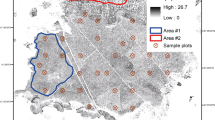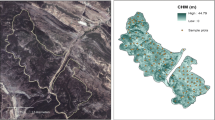Abstract
Fragmentation of the forests affects forest ecosystems by changing the composition, shape, and configuration of the resulting patches. Subsequently, the prevailing conditions vary between patches. The exposure to the sun decreases from the patch boundary to the patch interior and this forms core and edge areas within each patch. Forest harvesting and, in particular, the clear-cut management system which is still preferred in many European countries has a significant impact on forest fragmentation. There are many indices of measuring fragmentation: non-spatial and spatial. The non-spatial indices measure the composition of patches, while the spatial indices measure both the shape and configuration of the resulting patches. The effect of forest harvesting on fragmentation, biodiversity, and the environment is extensively studied; however, the integration of fragmentation indices in the harvest scheduling model is a new, novel approach. This paper presents a multi-objective integer model of harvest scheduling for clear-cut management system and presents a case study demonstrating its use. Harvest balance and sustainability are ensured by the addition of constraints from the basic principle of the regulated forest model. The results indicate that harvest balance and sustainability can be also achieved in minimizing fragmentation of forest ecosystems. From the analyses presented in this study, it can be concluded that integration of fragmentation into harvest scheduling can provide better spatial structure. It depends on the initial spatial and age structure. It was confirmed that it is possible to find compromise solution while minimizing fragmentation and maximizing harvested area.




Similar content being viewed by others
References
Aouni B, Kettani O (2001) Goal programming model: a glorious history and a promising future. Eur J Oper Res 133:225–231. doi:10.1016/S0377-2217(00)00294-0
Baskent EZ (1999) Controlling spatial structure of forested landscapes: a case study towards landscape management. Landsc Ecol 14:83–97. doi:10.1023/A:1008071307848
Baskent EZ, Jordan GA (1995) Characterizing spatial structure of forest landscapes. Can J For Res 25:1830–1849. doi:10.1139/x95-198
Baskent EZ, Jordan GA (1996) Designing forest management to control spatial structure of landscapes. Landsc Urban Plan 34:55–74. doi:10.1016/0169-2046(95)00200-6
Bertomeu M, Romero C (2001) Managing forest biodiversity: a zero-one goal programming approach. Agr Syst 68:197–213. doi:10.1016/S0308-521X(01)00007-5
Bettinger P, Boston K, Siry JP, Grebner DL (2009) Forest management and planning. Elsevier Inc, Atlanta
Bunnell FL, Huggard DJ (1999) Biodiversity across spatial and temporal scales: problems and opportunities. For Ecol Manag 115:113–126. doi:10.1016/s0378-1127(98)00392-2
Cerny M, Parez J, Malik Z (1996) Yields and enumeration tables for the main tree species (spruce, pine, beech, oak). The Institute for Forest Ecosystem Research, Jílové u Prahy
Clemens MA, ReVelle CS, Williams JC (1999) Reserve design for species preservation. Eur J Oper Res 112:273–283. doi:10.1016/s0377-2217(98)00157-X
Coops NC, Gillanders SN, Wulder MA, Gergel SE, Nelson T, Goodwin NR (2010) Assessing changes in forest fragmentation following infestation using time series Landsat imagery. For Ecol Manag 259:2355–2365. doi:10.1016/j.foreco.2010.03.008
Crowe K, Nelson J, Boyland M (2003) Solving the area-restricted harvest-scheduling model using the branch and bound algorithm. Can J For Res 33:1804–1814. doi:10.1139/X03-101
Das JK, Nautiyal JC (2004) Forest variability index: a vector quantifying forest stand diversity and forest compactness. For Policy Econ 6:271–288. doi:10.1016/j.forpol.2004.03.003
Davis LS, Johnson KN, Bettinger P, Howard TE (2001) Forest management: to sustain ecological, economic, and social values. McGraw-Hill Higher Education, New York
de Oliveira F, Volpi NMP, Sanquetta CR (2003) Goal programming in a planning problem. Appl Math Comput 140:165–178
Diaz-Balteiro L, Romero C (2003) Forest management optimisation models when carbon captured is considered: a goal programming approach. For Ecol Manag 174:447–457. doi:10.1016/S0378-1127(02)00075-0
Diaz-Balteiro L, Romero C (2004) Sustainability of forest management plans: a discrete goal programming approach. J Environ Manag 71:351–359. doi:10.1016/j.jenvman.2004.04.001
Dore T, Makowski D, Malezieux E, Munier-Jolain N, Tchamitchian M, Tittonell P (2011) Facing up to the paradigm of ecological intensification in agronomy: revisiting methods, concepts and knowledge. Eur J Agron 34:197–210. doi:10.1016/j.eja.2011.02.006
Echeverria C, Newton AC, Lara A, Benayas JMR, Coomes DA (2007) Impacts of forest fragmentation on species composition and forest structure in the temperate landscape of southern Chile. Glob Ecol Biogeogr 16:426–439. doi:10.1111/j.1466-8238.2007.00311.x
ESRI (2014) ArcGis Desktop Reference Manual. In
Fahrig L (1992) Relative importance of spatial and temporal scales in a patchy environment. Theor Popul Biol 41:300–314. doi:10.1016/0040-5809(92)90031-N
Fahrig L (2001) How much habitat is enough? Biol Conserv 100:65–74
FAO (2009) Glossary on organic agiculture. FAO, Rome
Franklin J (1993) Preserving biodiversity—species, ecosystems, or landscapes? Ecol Appl 3:202–205. doi:10.2307/1941820
Gonzalez J, Palahi M, Pukkala T (2005) Integrating fire risk considerations in forest management planning in Spain—a landscape level perspective. Landsc Ecol 20:957–970. doi:10.1007/s10980-005-5388-8
Gurobi Optimization (2014) Gurobi Optimizer Reference Manual. In
He HS, DeZonia BE, Mladenoff DJ (2000) An aggregation index (AI) to quantify spatial patterns of landscapes. Landsc Ecol 15:591–601. doi:10.1023/A:1008102521322
Hernandez-Stefanoni JL (2006) The role of landscape patterns of habitat types on plant species diversity of a tropical forest in Mexico. Biodivers Conserv 15:1441–1457. doi:10.1007/s10531-005-0598-6
Hlasny T, Matyas C, Seidl R, Kulla L, Merganicová K, Trombik J, Dobor L, Barcza Z (2014) Climate change increases the drought risk in Central European forests: what are the options for adaptation. For J 60:81–87. doi:10.2478/forj-2014-0001
Hunter M, Schmiegelow F (2011) Wildlife, forests, and forestry principles of managing forests for biological diversity, 2nd edn. Prentice Hall, Upper saddle River
Konoshima M, Marušák R, Yoshimoto A (2011) Spatially constraints harvest scheduling for strip allocation under Moore and Neumann neighbourhood adjacency. J For Sci 57:70–77
Martins I, Ye MJ, Constantino M, Fonseca MD, Cadima J (2014) Modeling target volume flows in forest harvest scheduling subject to maximum area restrictions. Top 22:343–3462. doi:10.1007/s11750-012-0260-x
McCarl BA, Spreen TH (2011) Applied mathematical programming using algebraic systems. Texas A&M University, Texas
Murray AT (1999) Spatial restrictions in harvest scheduling. For Sci 45:45–52
Ohman K (2000) Creating continuous areas of old forest in long-term forest planning. Can J For Res 30:1817–1823. doi:10.1139/cjfr-30-11-1817
Ohman K, Eriksson LO (1998) The core area concept in forming contiguous areas for long-term forest planning. Can J For Res 28:1032–1039. doi:10.1139/cjfr-28-7-1032
Ohman K, Lamas T (2003) Clustering of harvest activities in multi-objective long-term forest planning. For Ecol Manag 176:161–171. doi:10.1016/S0378-1127(02)00293-1
Ohman K, Lamas T (2005) Reducing forest fragmentation in long-term forest planning by using the shape index. For Ecol Manag 212:346–357. doi:10.1016/j.foreco.2005.03.059
Ohman K, Wikstrom P (2008) Incorporating aspects of habitat fragmentation into long-term forest planning using mixed integer programming. For Ecol Manag 255:440–446. doi:10.1016/j.foreco.2007.09.033
Ripple WJ, Bradshaw GA, Spies TA (1991) Measuring forst landscape patterns in the Cascade Range of Oregon, USA. Biol Conserv 57:73–88. doi:10.1016/0006-3207(91)90108-l
Rutledge D (2003) Landscape indices as measures of the effects of fragmentation: can pattern reflect process?. DOC Sciences Internal Series, Wellington
Schumaker NH (1996) Using landscape indices to predict habitat connectivity. Ecology 77:1210–1225. doi:10.2307/2265590
Soga M, Koike S (2012) Relative importance of quantity, quality and isolation of patches for butterfly diversity in fragmented urban forests. Ecol Res 27:265–271. doi:10.1007/s11284-011-0896-2
The MathWorks Inc (2012) MATLAB and Statistics Toolbox Release 2012b. The MathWorks Inc, Natick
Turner MG, Costanza R, Sklar FH, Oh HS, Kim DH, Openshaw S, Florax RHGM, Graaff TD (1989) Methods to evaluate the performance of spatial simulation-models. Ecol Model 48:1–18. doi:10.1016/0304-3800(89)90057-4
Williams JC, ReVelle CS (1996) A 0-1 programming approach to delineating protected reserves. Environ Plan B 23:607–624. doi:10.1068/b230607
Williams JC, ReVelle CS (1998) Reserve assemblage of critical areas: a zero-one programming approach. Eur J Oper Res 104:497–509. doi:10.1016/S0377-2217(97)00017-9
Wilson JD, Anderson R, Bailey S, Chetcuti J, Cowie NR, Hancock MH, Quine CP, Russell N, Stephen L, Thompson DBA (2014) Modelling edge effects of mature forest plantations on peatland waders informs landscape-scale conservation. J Appl Ecol 51:204–213. doi:10.1111/1365-2664.12173
Woolsey TS Jr (1922) American forest regulation. Chapman and Hall Ltd., London
Yamaura Y, Kawahara T, Iida S, Ozaki K (2008) relative importance of the area and shape of patches to the diversity of multiple taxa. Conserv Biol 22:1513–1522. doi:10.1111/j.1523-1739.2008.01024.x
Yoshimoto A, Brodie JD (1994) Comparative-analysis of algorithms to generate adjacency constraints. Can J For Res 24:1277–1288. doi:10.1139/x94-167
Zeng HC, Peltola H, Talkkari A, Venalainen A, Strandman H, Kellomaki S, Wang KY (2004) Influence of clear-cutting on the risk of wind damage at forest edges. For Ecol Manag 203:77–88. doi:10.1016/j.foreco.2004.07.057
Zeng HC, Pukkala T, Peltola H (2007) The use of heuristic optimization in risk management of wind damage in forest planning. For Ecol Manag 241:189–199. doi:10.1016/j.foreco.2007.01.016
Zeng HC, Peltola H, Vaisanen H, Kellomaki S (2009) The effects of fragmentation on the susceptibility of a boreal forest ecosystem to wind damage. For Ecol Manag 257:1165–1173. doi:10.1016/j.foreco.2008.12.003
Acknowledgments
This research was supported by the project of the National Agency for Agriculture Research (No. QJ1320230) and the Internal Grant Agency of Faculty of Forestry and Wood Sciences Czech University of Life Sciences in Prague (No. B0114).
Author information
Authors and Affiliations
Corresponding author
Rights and permissions
About this article
Cite this article
Marušák, R., Kašpar, J., Hlavatý, R. et al. Alternative Modelling Approach to Spatial Harvest Scheduling with Respect to Fragmentation of Forest Ecosystem. Environmental Management 56, 1134–1147 (2015). https://doi.org/10.1007/s00267-015-0558-1
Received:
Accepted:
Published:
Issue Date:
DOI: https://doi.org/10.1007/s00267-015-0558-1




